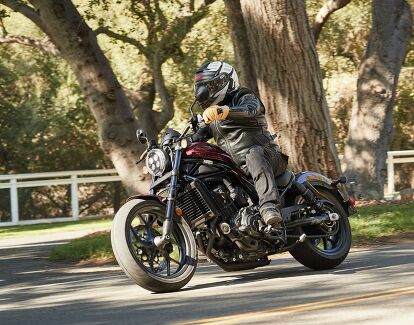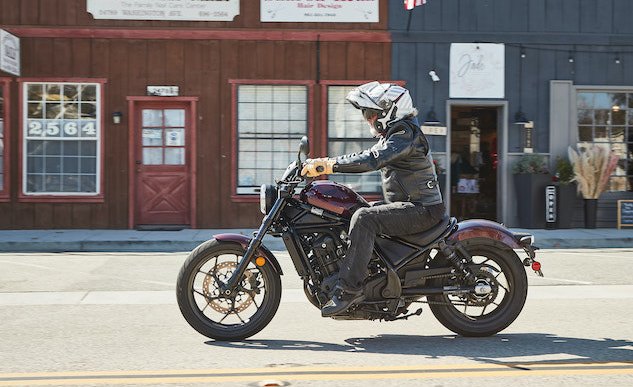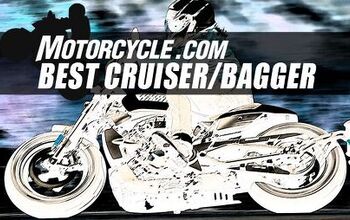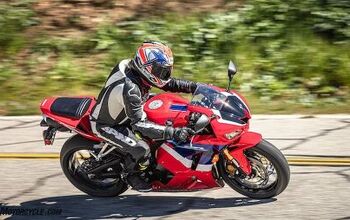2021 Honda Rebel 1100 DCT First Ride Review
I get it. I understand all of us don’t want to be seen in public, especially in certain publics, on a Honda NC750X virtue signalling our tiny, 745cc 60-mpg carbon footprint. Nor does everybody want to assert their elite adventurousness aboard an Africa Twin in $2000 worth of Gore-Tex® regalia if they’re not all that interested in striking off into the hinterlands – especially if they already live there. You might get away with those things in California, but everybody doesn’t live in Lala-land. Only 12% of Americans. And plenty of them aren’t interested in being Power Rangers either.
2021 Honda Rebel 1100 DCT
| Engine | 18.0/20 |
| Suspension/Handling | 12.5/15 |
| Transmission/Clutch | 9.75/10 |
| Brakes | 8.0/10 |
| Instruments/Controls | 4.5/5 |
| Ergonomics/Comfort | 7.5/10 |
| Appearance/Quality | 9.0/10 |
| Desirability | 8.5/10 |
| Value | 9.5/10 |
| Overall Score | 87.25/100 |
For a helluva lot of American motorcyclists, tradition is important, and a lot of people want something that looks traditional on the outside, even if it’s verging on revolutionary inside. I think that’s kind of what’s going on with Honda’s new Rebel 1100.
The profile says cruiser, but a slightly closer look reveals Honda’s done trying to copy Harley with fake cooling fins on flaccid V-twins and plastic chrome gewgaws (though the Fury et al remain in the lineup). The new Rebel wears its 1084cc Unicam parallel Twin and cooling system outside its pants for all the honest world to feel, even as the Honda badging remains subdued.
Closer inspection of the DCT version also reveals the absence of a clutch lever and shifter. Before this Rebel, the only way to get an automatic trans was via the aforementioned Hondas in paragraph one, or in a scooter or Gold Wing. If the goal has been to recruit new riders, that’s downright baffling. Hats off to Honda for making at least some effort. Honda’s Euro website says the dual-clutch transmission technology has reached its 11th year of production, and more than 140,000 Honda two-wheeled vehicles equipped with DCT have been sold in Europe since 2010.
DCT!
Ya just plink the thing into D for Drive with your right thumb, and from there Honda’s Dual Clutch Transmission will do the rest; the one in the Rebel must be about Generation 3. Setting the ride mode to Standard, Sport, Rain, or User gives the trans its marching orders on when to shift. Or, at any time, a light touch of the paddle shifter at your left index finger gets you an instant upshift. Downshifts are instigated with your left thumb, and no worries if you’re heeled over in a tight left at the time; shifts up or down are seamless and smooth. It’s still easy to honk the horn when you want to signal a turn and vice-versa, but the downshifter at least stands alone. Using the paddles quickly becomes reflexive.
Africa Twin Power
Honda tells us this 270-degree crankshafted AT engine is from the 2020 version: The same attributes that make it a good Adventure motor serve it well in cruiser guise as well. The Unicam head keeps the weight mostly low, and with the heavier engine parts toward the bike’s center of gravity. The heaviest bit might be the flywheel mass, which Honda says is 20% heavier for 32% more inertia. We’ve got revised cam timing and lift, designed to “change volumetric efficiency between cylinders for a unique pulse feeling at 4,000 rpm,” and the thing does make a unique nasal Canadian goose honk through its tuned airbox and exhaust when you whack the throttle open, along with eye-opening acceleration.
New riders will love not having to clutch, but on this one, they need to be made aware that opening the throttle in first gear results in going somewhere immediately, especially in Sport mode. With no clutch to modulate, low-speed parking lot maneuvers require making sure the trainee is also well acquainted with how to drag the rear brake to maintain balance.
American Honda doesn’t deal in such crassities as horsepower numbers, but Honda of Italy is all over it: 87 hp at 7,000 rpm with 72 ft-lbs torque at 4,750 rpm for the Rebel it says, versus 102 hp @7500 rpm and 77 ft-lbs @ 6,250 rpm for the Africa Twin.
So the Rebel’s giving up 7% of the AT’s torque – but getting there 1500 rpm sooner. In a cruiser, that seems like a good trade-off. A couple of riders in our group were able to keep the front wheel a foot or two in the air into second gear: There is wheelie control, but turning off traction control disables it as well.
We haven’t ever managed to run a DCT bike on the Dynojet yet, but the editorial butt dyno registers about 80 rear-wheel horsepower, and 72 ft-lbs of torque almost seems like a conservative estimate. If you want your power right now from a stop, the Rebel delivers, especially in Sport mode. As for top speed, it feels like it’s fixing to blow through the Ton with ease right when the governor kicks in at 100 mph. It’s probably for your own good, son.
Ergonomy
Somebody on the ride said, “mid controls suck,” and somebody else answered “not as much as forward controls.” I agree. The Rebel had my hip flexors concerned at first, but even my old body adapted pretty quickly to the highish pegs beneath the 27.5-inch seat. I could hang my 30-in legs atop the pegs when droning along to stretch them out, and I think the optional passenger pegs would work well too as a seating option. For 5’8” me the handlebar was a bit forward; later I was able to rotate it down and rearward a smidge, where it was just about perfect. For me, the thick seat’s a fine shape and comfortable enough. Overall, in spite of the cruiser appearance, the Rebel has you in a reasonably okay posture for attacking curves, a thing it does surprisingly well.
It’s also not bad at running along at 80 or 85 mph on the freeway at 5000 rpm: You’re sat down low enough behind the fuel tank and instrument pod that they do deflect a bit of windblast, and the magic that is standard electronic cruise control means you can give either hand a break as needed. Also, this is a smoooooth-running Twin. Honda says: “The secondary vibrations are neutralized by the reciprocal movement of the pistons, while the primary inertial and coupling vibrations are canceled out by the use of biaxial countershafts.”
The intended milieu of the cruiser, though, is cruising, and for blathering around town the Rebel, especially the DCT, is king. The low seat is swell for stop-and-go. I was initially miffed that we weren’t lane-splitting through city traffic on our official Honda SoCal press ride, but after a while I stopped minding because sitting there low on the Rebel on a nice day’s as easy as sitting in a car with an automatic. I have to say, the cruiser people may be on to something; I think the Our Time ladies were checking me out even more than usual. Short bikes make you look taller. Oh yess… go GPTB. I’m a bad boy, a Rebel…
There’s really nothing in particular that stands out on the Rebel, but Honda did a nice job with the round-tube frame and the deep paint on the seamless tank on top of it. Those fenders are real steel, and it being a Honda, there are zero unsightly wires or dangling participles. Obviously it’s a cruiser, but this Honda’s not trying to be anything it’s not or to hide anything it’s ashamed of. It’s elemental.
Suspense
The downside of cruising is the same as it ever was. As long as the pavement’s smooth, all is swell. But where there be bumps, the bigger ones are going right up your spinal column and attempting to dislodge whichever of your internal organs are still connected to it. You just can’t absorb bumps with your legs and feet nearly as well as you can on a non-cruiser.
The 43mm cool purple nitrided fork up front does nice work, and the dual-rate piggyback-res shocks out back do the best they can with their 3.7 inches of wheel travel (both are preload-adjustable), but you’re still taking some pretty heavy body blows over the big bumps unless you pull yourself up by the arms when you see them coming. Some of them sneak up on you. Ouch.
For sporty backroad use, the suspension’s dialled. With 4.3 inches of trail, a 59.8-in. wheelbase, that fat 18-in. front tire and its low cg, the Rebel’s more about stability than quick handling. But that doesn’t mean it’s not as fun as any other motorcycle to throw at corners. Honda claims it’s got 35 degrees of lean in both directions, but it feels like more. The footpegs don’t begin to drag until it feels like you’re going plenty fast for the Dunlop D428 cruiser tires. For a sportbike, 509 pounds is a bit porcine; for a cruiser it’s pretty light. (The last Sportster 48 we tested [my kid did nice work on that one!] claimed to weigh 551 lbs. Indian specs 555 lbs. for its Scout Bobber.) If you did opt for the 6-speed manual Rebel, it’s 22 lbs lighter, at 487. (Honda’s claimed weights have been very close to our measured ones lately.)
The DCT doesn’t care if you decide to bang it down another gear midcorner (in fact it doesn’t “bang” at all or upset the chassis in the least) to make the giant angry goose honk again, but the engine’s so torquey in the middle it’s usually faster to just leave it in the gear you’re in.
Back on the gas, you can count on the DCT to upshift again every time the LCD tachometer that runs around the perimeter of the big single instrument gets to “7”. You’ve got Rain, Standard, Sport and User modes, and once you’ve loaded your chosen levels of power, traction control, engine braking and DCT function into User, it stays that way even after you turn off the ignition.
Maybe you wanna short-shift? Bink the paddle with your left index finger. Instant shift every time. Earlier DCTs I rode didn’t always downshift when you wanted them to: With the Rebel version, every time I was about to thumb the downshift paddle – be it braking into a corner or coming to a stop – the DCT would do it for me, complete with throttle blip, like it read my mind – sometimes even two rapid downshifts into tight corners.
I like Sport mode, but when you’re just cruising along, it holds gears longer than you want before upshifting. That’s not even a problem, since by now you’re reflexively fingering the upshift paddle. You could switch into Standard or Rain mode to get lower-rpm upshifts and the less aggressive shifting program, but then you’re getting less throttle response too. If you’re just getting started on this bike, that’s probably not a bad thing. Anyway, it’s all easy to figure out even without consulting a millennial, and easy to see on the LCD display.
DCT in short, is awesome 99% of the time. “Additional benefits,” says Honda, “include durability (no damage due to poorly engaged gears), inability to switch off, reduced stress in urban driving, reduced rider fatigue and more concentration on driving in terms of cornering trajectories, braking and acceleration points.” Pretty much spot-on.
I’m not normally a cruiser guy, but then the Rebel 1100’s not a normal cruiser (neither was the sweet Rebel 500 we tested last year). This one goes around corners like a sportbike when you ask it to, goes as fast as you ever need to go (as long as that’s not faster than 100), and it’s as convenient to run around on as a scooter, thanks to the DCT. You’ll need a cup holder for your coffee somewhere. Naturally, Honda already has nice saddlebags you can order up at time of purchase, along with a bunch of other things including heated grips, a batwingish fairing and windshield, etc.
And the price is right too. Honda says its Rebels 300 and 500 have been big successes.
But when owners of those bikes want to move up the ladder, they’ve had no choice but to defect to a different brand: 64% of Rebel 300 trade-ins and 73% of Rebel 500 traders moved to “other brands,” Honda laments. Now that the 1100 is here, they’ve got an excellent reason to ride right back to the Honda dealer at trade-in time.
And for $9,999, this one should draw a lot of riders of “other brands” too. (Sounds like by this time next year, there’ll also be a standard style Honda with this engine and DCT for them to look at, probably called something like NT1100.)
There’ve been a lot of unmemorable cruisers to try to remember over the decades, but I’m pretty sure the Rebel 1100 is the most fun I’ve had riding one, by a pretty fair margin. (Is the Triumph Rocket 3 a cruiser?) Whatever category you want to put it in (style without stereotypes, Honda says), it feels like a high-functioning bi-partisan motorcycle even us coastal elites can get behind.
2021 Honda Rebel 1100 DCT
+ Highs
- Looks great, less filling: 509 lbs. wet
- A cruiser that thinks it’s a sportbike
- How did people live before DCT, daddy?
– Sighs
- Front brake’s a bit spongy on our bike
- Cruiser ergos here are less uncomfortable than on most cruisers
- I can’t bitch that there’s no standard cruise control
In Gear

Helmet: [url=https://www.amazon.com/gp/product/B07HL25YDS?ie=UTF8&tag=vs-motorcycle-honda-rebel-1100-20&camp=1789&linkCode=xm2&creativeASIN=B07HL25YDS]Shoei Neotec II Splicer[/url][/b] $799[/p]
- Jacket: [url=https://vansonleathers.com/mens-collection-of-motorcycle-jackets-racing-suits-pants-chaps-more/39-model-AR-rayon-firenze-leather-motorcycle-jacket-AR2.html]Vanson AR3[/url] $562.50[/b]
- Gloves: [url=https://www.aerostich.com/aerostich-competition-elkskin-ropers.html]Aerostich Competition Roper[/url][/b] $70
- Jeans: [url=https://www.amazon.com/gp/product/B07FC49SBT?ie=UTF8&tag=vs-motorcycle-honda-rebel-1100-20&camp=1789&linkCode=xm2&creativeASIN=B07FC49SBT]Trilobite Elastic Men’s Jeans[/url][/b] $179
Boots: [url=https://www.amazon.com/gp/product/B075K5TXMJ?ie=UTF8&tag=vs-motorcycle-honda-rebel-1100-20&camp=1789&linkCode=xm2&creativeASIN=B075K5TXMJ]Sidi Arcadia Tex[/url][/b] $179[/b][/p]
2021 Honda Rebel CMX 1100 DCT Specifications | |
|---|---|
| MSRP | $9,999 ($9,299 non-DCT) |
| Engine Type | 1084cc liquid-cooled parallel-Twin, SOHC, four valves per cylinder |
| Bore and Stroke | 92mm x 81.5mm |
| Compression Ratio | 10.1:1 |
| Rear Wheel Horsepower | 87 hp @ 7000 rpm (claimed) |
| Torque | 72 lb-ft @ 4750 rpm (claimed) |
| Transmission | 6-speed Dual Clutch Transmission (automatic) |
| Final Drive | Chain |
| Front Suspension | 43mm fork; adjustable for spring preload, 4.8 in. travel |
| Rear Suspension | Dual Showa shocks with pressurized reservoirs; adjustable for spring preload, 3.7 in. travel |
| Front Brake | Single 330mm disc, radial-mount 4-piston caliper, ABS (non-lean sensitive) |
| Rear Brake | 256mm disc, 1-piston caliper, ABS |
| Front Tire | 130/70-18 |
| Rear Tire | 180/65-16 |
| Rake/Trail | 28.0 deg/4.3 in |
| Wheelbase | 59.8 in. |
| Seat Height | 27.5 in. |
| Curb Weight | 509 lbs. (claimed); 487 non-DCT |
| Fuel Capacity | 3.6 gal. |
| Observed Fuel Mileage | 41 mpg |
| Colors | Metallic Black, Bordeaux Red Metallic |
| Warranty | 1 year transferable, unlimited-mileage limited warranty; extended coverage available with a Honda Protection Plan. |
More by John Burns

















































































Comments
Join the conversation
This COULD HAVE BEEN the perfect light touring bike for smaller riders. However, it just doesn't have the range with that small gas tank. If someone comes out with a 5+ gallon after-market tank, then I'd buy this bike. Just add a windshield, a rack and a dry duffle bag AND GO! Although, I'd get the manual transmission, as I have ZERO interest in the DCT version.
Disappointed in the Honda 1100 Rebel Bagger. Best motorcycle I have ever owned, 2006 Honda Shadow Sabre VT1100. (Rode almost every day for 12 years with a couple of minor issues. Easy to clean, maintain and a blast to ride). Seeing I am in the market for a new bike, I was really hoping to find an updated version in the 1100 Rebel Badger to fill that loss. Unfortunately, going from shaft drive to chain has to be the biggest loss! The Bobber fenders do little to protect the bike and the rider and while the wheels are not a deal breaker, the solid aluminum rims were so easy to wipe down. I have tried to convince Honda a few time to bring back updated version of the 2006 Honda Shadow Sabre VT1100 to no avail. Guess they have their reasons.